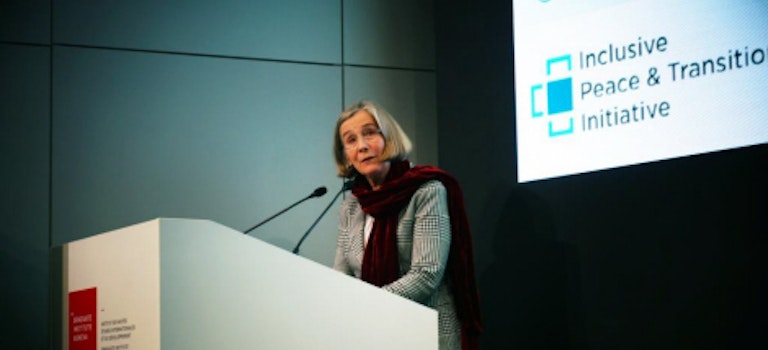Despite growing recognition of the crucial role of women in conflict resolution and prevention, women still face difficulties not only in accessing the negotiation table but also in influencing discussions and decision-making once part of a mediation process. Women’s effective participation in peace negotiations is often hampered by the negative or indifferent attitudes of conflict parties towards inclusive processes and addressing gender-specific needs; and gender-discrimination stemming from broader society.
How can we prevent the exclusion of women in mediation processes? On 9 November, the Swedish Mission co-hosted the event “Making Women Count in Peace Negotiations: An Insider’s Perspective from Colombia, Syria, and the Philippines” together with Inclusive Peace & Transition Initiative (länka) and the Permanent Mission of Switzerland as part of Geneva Peace Week (länka). The event aimed to trigger an honest discussion and shared powerful insider’s perspective testimonials from three eminent guests: Olga Marín from Colombia, Member of the International Commission of the FARC-EP, Advisor of the Gender Sub-commission during the peace negotiations in Havana and Member of the Joint Monitoring and Verification Mechanism; Teresita Quintos-Deles from The Philippines, Former Presidential Adviser on the Peace Process in the Philippines; and Staffan de Mistura, United Nations Special Envoy for Syria. The event was moderated by Dr. Thania Paffenholz, Director of the Inclusive Peace & Transition Initiative.
In her opening speech to a packed room, Swedish Ambassador Veronika Bard explained Sweden’s priorities relating to gender equality as part of its feminist foreign policy, but also stressed the need to engage men in the discussion on including women in peace processes.
Olga Marín spoke about the reasons women join armed groups like the FARC, stating personal and political choices and seeking alternatives to structural violence and patriarchy in Colombian society. In the movement, the women had to prove both their intellectual and physical capacities whereas mens’ were assumed. The women also had to deal with sexual and reproductive health issues and family planning whilst being involved as combatants. A lot of stereotypes persist around feminism in Colombia, which has been politicized in the current context of the peace agreement.
Teresita Quintos-Deles a government negotiator in the Peace Process between the Government of The Philippines and the Moro Islamic Liberation Force (MILF) in Mindanao emphasized that still today some groups do not know how to "fight with women" at the peace negotiation table. She also stressed that it is not only about including women, but the right diversity among them, with consideration for ethnicity, age and experience. She shared the doubts and stereotypes that surrounded the appointment of Miriam Coronel Ferrer as head of the government negotiating panel, who became the first woman signatory to a major peace agreement. She shared examples of how women dealt with some of the dynamics in the negotiations differently. For example, on the morning of Valentine’s Day, the women offered chocolates to MILF male negotiators with the message: “yes we are negotiating but there’s more: it’s about living together as people”.
Staffan de Mistura concurred that creativity to dealing with the inclusion of women as well as other negotiation blockages is crucial, and he was learning from women in this regard. He recalled his experience in Nicaragua, where a woman came up with the idea to have a cease-fire surrounding vaccinations. For three days the only shots that occurred were those for vaccination for both the government and the guerrilla side. In the current Syria negotiations, the UN has insisted on female participants but those selected on both sides did not engage. As a mediatior he therefore proposed to pick women as advisors to the negotiations. This diverse group of women had more influence in this capacity. But difficulties were also identified and the need of new thinking was highlighted. “We need to be constantly creative because it won’t happen automatically”, he concluded.
Wrapping up the discussion, Thania Paffenholz concluded that it takes creativity, courage of both women and men and persistence over time to make inclusion possible. It is time to move beyond the debate about why including women is key to peace processes, to understanding the practical challenges and experiences that can make it happen as part of broader efforts to secure sustainable peace.
